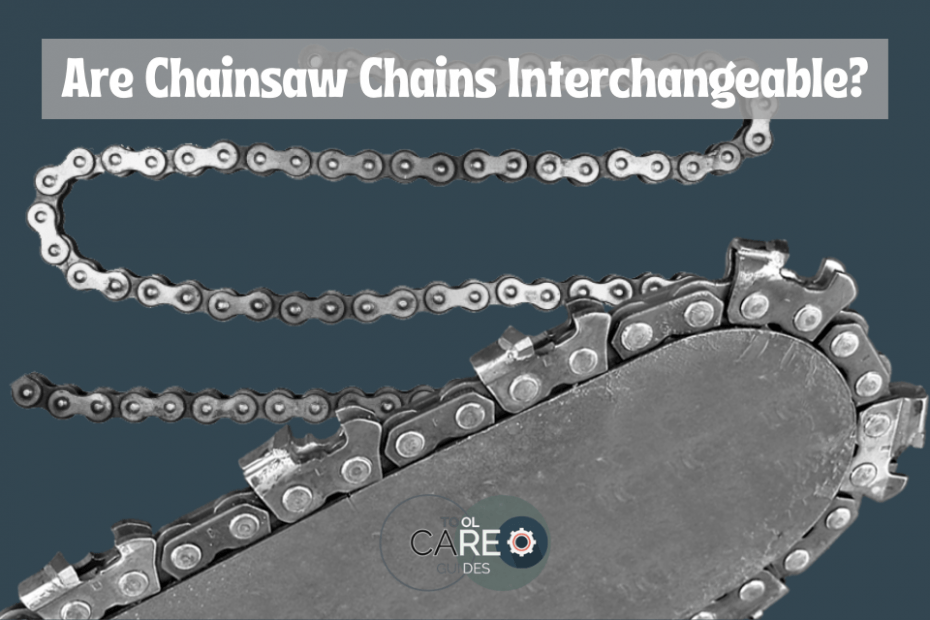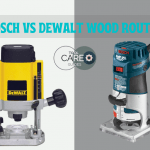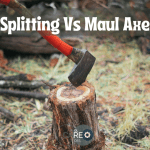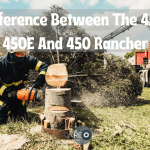Quick Overview of This Article
If you are new to chainsaws, you might be wondering if you can interchange the chain when it becomes blunt. However, this is always confusing since numerous brands have various chain types. You might not have an idea if a particular brand or type of chain is a good fit for your chainsaw or not.
The most fundamental key is always to know the type of chain you are using, the dimensions, and the tasks you want the chainsaw to be performing. With this information, you can find a replacement chainsaw when the current one becomes dull or gets damaged.
Back to your question, “Are chainsaw chains interchangeable?” Well, chainsaw chains are not universal, you can replace the chainsaw chain, but you must take caution. There are different manufacturers and brands, and not all of them are interchangeable. More so, before changing the chain, you must have the pitch, length, and gauge details.
If you replace it with the wrong chain, it may lead to severe injuries to the chainsaw operator and damage your chainsaw.
But this should not worry you or make you not replace your old chain with a new one. This article will explore the nitty gritty of interchanging chain saw chains. You will be equipped with the correct information to replace chainsaw chains quickly and safely by the end of the post.
Chainsaw Types and How Their Chains Differ
Even before recording the details of your old chain and matching it with the new one, you must understand that the chainsaw type also matters. The type of your chainsaw, either gas-powered or electric, will determine the type of chainsaw chain you need. Let’s look at the two types and how they differ.
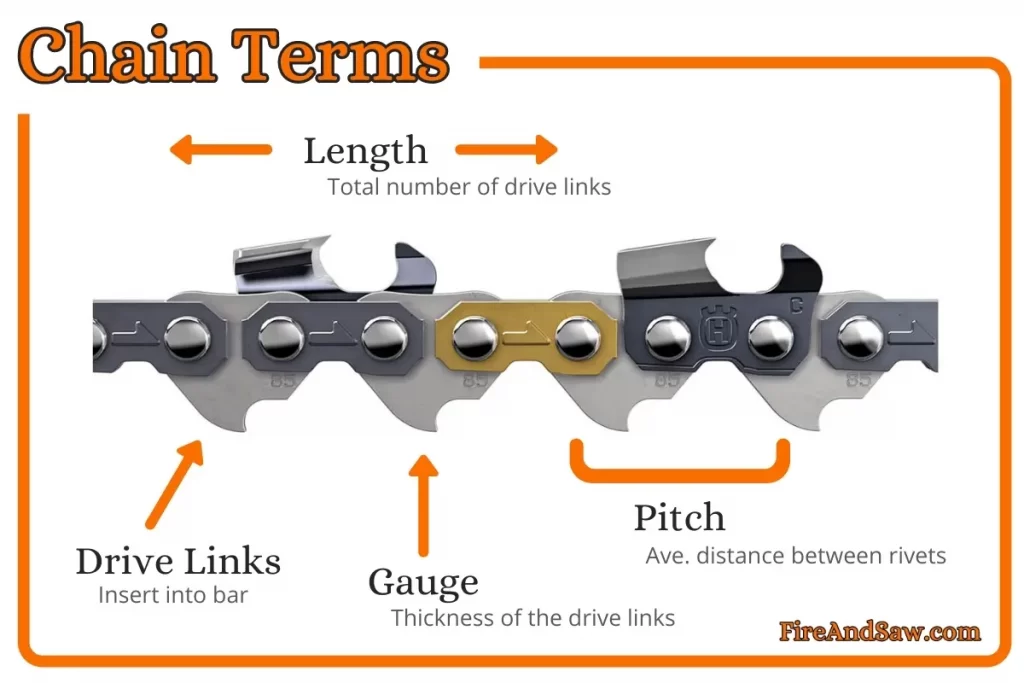
Electric Chainsaws
Electric-powered chainsaws are mainly used for lightweight duties such as tree felling and softwood pruning around the homestead. Generally, electric chainsaws have superb usability due to their lightweight and short bars. However, the most distinguishing factor between a gas-powered and electric chainsaw model is the power they produce.
Gas-powered saws produce higher power output than electric models. Therefore, they are the best choice for heavy duties like ripping logs, felling hardwood trees, and working long hours. So, if you need a chainsaw with high power output and can cut for longer hours, the gas-powered chainsaw is your best fit.
Before buying a chainsaw, ensure you check if the manufacturer has labeled that you should use it for electric chainsaw models in the cover. If you have any doubts, ask the dealer before making the purchase.
Gas-Powered Chainsaws
Gas-powered chainsaws are versatile and powerful enough to accomplish any cutting task you throw at them. These saws can prune, clear bushes, or fall trees for several hours non-stop. Some smaller models are suitable for use around your home and the large and powerful ones that lumberjacks prefer.
Due to their high-power output, gas-powered chainsaws can perform better and accomplish more than electric chainsaws. More so, they have larger chainsaw chains than electric chainsaws.
How to Measure the Dimensions of your Chainsaw Chain

Whenever you purchase a new chainsaw, you should record the measurements of the chain before starting to operate it. You can note them on a notebook or your smartphone. The details are written at the saw’s bar and have all the specifications you may need while looking for a replacement chain.
However, after using the chainsaw, the writings start to rub and fade, and over time, they become completely invisible and unreadable. If that has already happened, don’t worry. You can measure the dimensions of the chain using the steps we shall discuss below.
- Measuring the Bar Length of the Chainsaw
The first thing you need to note down is the bar length of your specific chainsaw. To determine the length, use a measuring tape to measure the length from the engine’s body base to the cutting tip end. If you measured and didn’t end up with a whole number, you should round off the finding to the nearest inches
For instance, if you find out that the bar length is 13.75 inches, you should round off and record the bar length as 14 inches.
- Measuring the Pitch of the Chainsaw
The chain size or the pitch is the measurement between the links of the saw. To determine the chain size, measure the distance from the first rivet to the third. Next, divide the result by half. Most chainsaws have a pitch measurement of ⅜ inches.
- Measuring the Gauge
The gauge of the chainsaw is the width of its bar groove. The most straightforward way to determine the saw’s gauge is using a quarter, dime, and a penny. However, before you measure the gauge, ensure that you remove all the debris in the groove using a flat-head screwdriver.
Try to insert the coins into the bar groove until you find the one that fits in perfectly without applying any force. The circumference of the coin that fitted perfectly is the correct gauge of your chainsaw. Here is a chart to guide you:
- Penny: .058 inches
- Dime: .050 inches
- Quarter: .063 inches
Are There Specialized Chains for Chainsaws?
Having learned how to determine the measurements of your chainsaw, it’s time to learn about the different types of chains that you can purchase. Over the years, chainsaw experts have developed specialized chains with a unique design to perform a specific duty. These specialized chains are more advanced than the Original Equipment Manufacturer (OEM) since they carry out particular tasks, cut faster, and are lightweight.
- Ripping Chains
The ripping chain is the most expensive in the market. It has a unique design that makes it cut along the grain of the wood instead of the typical chains that cut against the wood. Due to this design, it delivers precise and cleaner cuts and is perfectly designed for milling logs into planks.
Unlike other types of chains, ripping chains have blades that cut at lower angles. While the normal standard chain cuts at an angle of 300, ripping chains’ blades cuts at an angle of 100. Therefore, these special blades will cut smaller wood pieces from the lumber and deliver cleaner planks. One of the best ripping chains is the OREGON 72RD072G.
- Low-Profile Chains
Low-profile chains are the perfect choice if you have an electric chainsaw model. Compared to standard chains, they are lighter and with lower height which delivers a shallower cut. This lightweight design enables even electric chainsaws with low power output to cut faster than when using standard chains.
More so, this design makes them to deliver clean cuts without putting pressure on your chainsaw’s motor. Thus, your motor will run longer without any faults and you will spend lesser time repairing or maintaining your saw.
Since low-profile chains are affordable, you can install it on your electric chainsaw. However, you cannot install it if your chainsaw requires chains with more than 72 links. If you are looking for a well-performing low-profile chain, I recommend the OREGON 91VXL062G.
- Narrow Kerf Chains
Narrow Kerf chains are lightweight chains with narrower blades. Therefore, they are ideal for your electric chainsaw models. With their narrower blades and lightweight design, narrow kerf chains can be installed in low-horsepower chains and still deliver narrow cuts.
The main advantage of narrow kerf chains over standard chains is their advanced safety feature. They have the low-kickback feature which makes them user-friendly and safe to be used by inexperienced users or those who don’t use chainsaws frequently. You can go for the OREGON 95TXL066G narrow kerf chain.
Types of Cutters for Chainsaw Chains
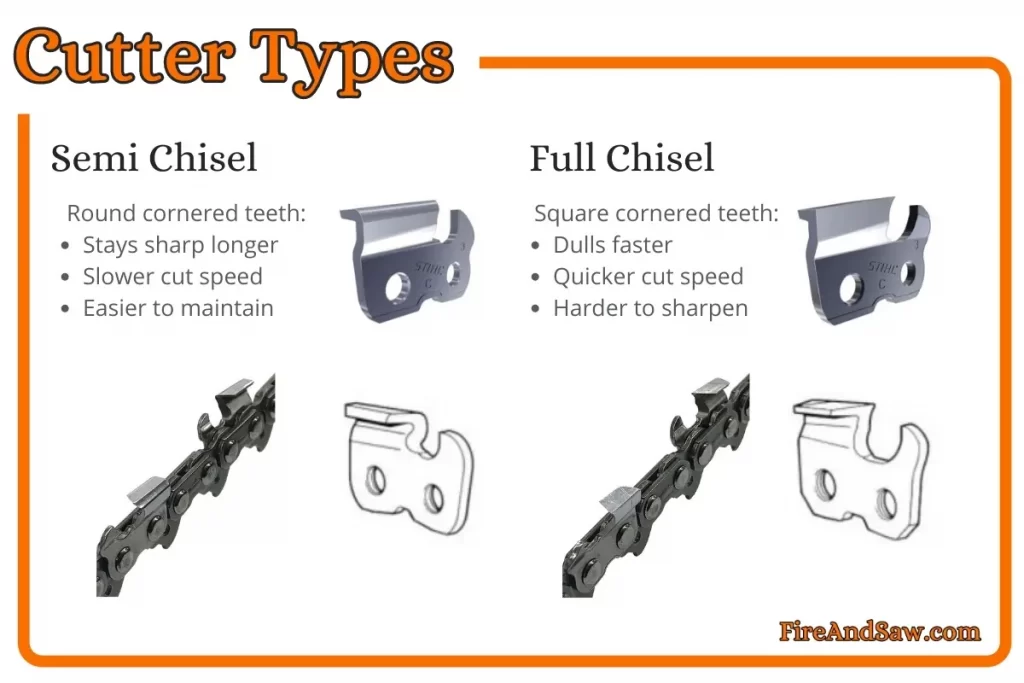
The types of cutters for chainsaw chains are categorized into two:
- Full chisel chains
- Semi-chisel chains
Full Chisel Chains
The full chisel chains are highly recommended for use by:
- Professional lumberjacks
- Landscapers; and
- Construction workers
Full chisel chains have square-shaped and sharp-tipped blades that can cut through limbs more efficiently and with speed. Though full chisel chains are efficient and can perform any task you throw at them with speed, they are not ideal for beginners or inexperienced chainsaw operators.
Semi Chisel Chains

Semi-chisel chains are highly recommended for beginners or anyone who want to perform light cutting tasks. They are different from full-chisel chains since their blades are rounded and run longer before they become dull. Further, they are advantageous because they are resistant to debris and dirt.
If you are a homeowner or casual user, it is highly recommended to get a semi-chisel chain since they require less sharpening and maintenance.
What Materials Are Chainsaw Chains Composed Of?
Chains are mainly manufactured using three materials:
- Chrome
- Diamond
- Carbide
Chains made from chrome are mainly installed in the factory, while those composed of diamond or carbide are manufactured to accomplish specific tasks.
- Chrome Tips
Blades with chrome tips are the most affordable and common chain-type material available. They are used to perform most lumber-cutting duties and are used in both semi-chisel and full chisel chains. It is helpful in most cutting tasks unless you need to cut through rigid materials.
- Carbide Tips
Carbide-tipped chains have more durable blades that can cut through hard materials. Due to this design, the carbide-tipped chain is beneficial to rescuers who require hard edges to cut through rooftops, frozen lumber, or waterlogged wood that regular chrome-tipped chains cannot cut.
- Diamond Tips
Diamond-tipped chains are the most expensive, robust, and durable chains available. Due to their robust feature, they are not produced to cut through softer materials such as lumber or tree limbs.
Chains with diamond tips are designed to be installed in powerful and robust machines that cut through hard surfaces such as concrete and solid rocks. Therefore, they are not ideal for use around the home since they are expensive and not applicable to cut through wood.
Can You Install a Chainsaw Blade Backwards?
One of the most frequently asked questions when it comes to replacing your chainsaw chain is, “Can I install a chainsaw blade backward?” More so, many people wonder if it is safe or dangerous to install a chainsaw blade backward.
Installing the bar and chain of your chainsaw is easy, but the trickiest part is determining if you installed it in the right way or backward. Therefore, you might end up installing it the wrong way without noticing. So, if you are wondering if you can install the chainsaw blade backward, the simple answer is yes, you can.
However, if you install it incorrectly (backward), it does not cut the wood or anything because the blade is not facing outwards. If you don’t know how to install a chainsaw blade, you should first observe a chainsaw with a blade installed on it to understand how it should look. When installing, you should ensure that the sharp edges fitted at the chain’s bottom are facing you and those at the top are not facing towards you.
Are Chainsaw Blades Universal?
The chainsaw blade, which is the cutting section of the chainsaw, houses the bar and the chain. Many people wonder if this part is universal or can be replaced between different models. However, you should note that it is not universal, and not all chainsaw chains or bars can be installed in your specific chainsaw model.
For a chain to be compatible with your chainsaw, the specifications should match the ones on your chainsaw bar. You can purchase chains from other brands besides your manufacturer as far as the specifications are compatible. So before making the buying decision, ensure that the chain can fit and be compatible with your chainsaw model.
Though you can get a chain or bar with the exact specifications of your current chainsaw, it is always imperative to consider the factory specifications of your chainsaw before you install the replacement parts.
Final Thoughts
There are many chainsaw blades with different blade configurations and sizes. Before purchasing a replacement chain, ensure that the specifications match your chainsaw model. Additionally, make sure that the chain fits well, is installed correctly, and is suited well for the task you want it to perform.
Lastly, chainsaws can cause severe injuries while mishandled, so always take the necessary precautions when handling a chainsaw. If this article has answered your question and is resourceful, share it with your loved ones. Comment below, and let us hear your thoughts!
